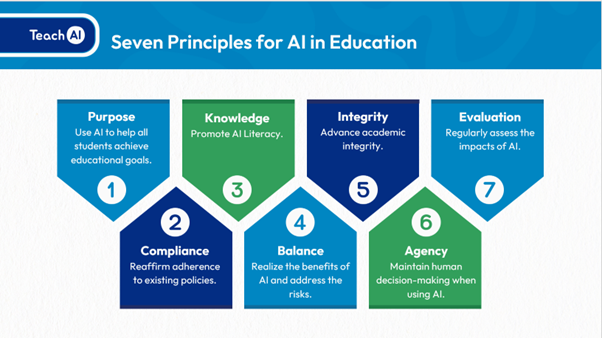In March 2023, we conducted our first webinar on the role of Artificial Intelligence (AI) in education, and published our first blogpost about the subject. At that time, the world was just beginning to grasp the potential of this innovative tool. Fast forward to the present day, and it’s clear that AI is no longer a concept but a reality. It’s making its presence felt across various professions and revolutionising the way people access information.
In 2023, a study conducted in Finland by Becker, Prather, Denny, & Leinonen revealed a consensus among students and teachers: Generative AI (GenAI) tools are not only becoming more common in classrooms but they are also considered crucial for future careers.
This finding highlights the necessity of training both educators and students with the knowledge and skills to use GenAI responsibly. Educational institutions need to be prepared to play an important role in this effort, making it necessary to establish comprehensive AI Guidance. This will ensure that everyone can use the power of AI, balancing the potential risks with the benefits.
However, a survey from a UNESCO Global Survey conducted in May 2023 indicates that only 7 percent of the education systems worldwide offer specific guidance on the use of generative AI. There is considerable scope for improvement in creating an environment that is both safe and beneficial to innovation.
“The survey results show that we are still very much in the wilderness when it comes to newly powerful generative AI and education,” said Sobhi Tawil, the UNESCO Director for the Future of Learning and Innovation.
Benefits and Risks: Education with AI
At present, our understanding of AI’s capabilities is merely the tip of the iceberg, and we can expect significant advancements in the years to come. However, we can already discern some of the potential benefits and risks that AI presents in the field of education. Recognising these is the initial step towards developing effective guidance. It’s important that we not only leverage the advantages of AI but also tread carefully to ensure its responsible use. Here are some benefits of AI in Education:
- Personalised learning: provides individualised learning paths based on student's strengths and weaknesses
- Accessibility: make education more accessible for students with disabilities
- Time-saving: Help reduce the workload of teachers and educators, AI's ability to automate repetitive tasks.
- Preparation for the future
Challenges
- Data Privacy and Security: AI systems need data to work well, which might involve collecting sensitive details about students. If this data is handled poorly or used wrongly, it could break privacy rules.
- Bias: AI systems are only as fair as the data they learn from. If they learn from biased data, they could continue and even increase these biases, leading to unfair results for certain groups of students.
- Learning without understanding: AI tools for teaching might encourage memorising facts instead of understanding them deeply. For example, students might use AI tools to finish assignments without really understanding the main ideas.
- Equity issues: Not all students have the same access to computers and the Internet. This imbalance could speed up the increase in the achievement gap between students from different financial backgrounds.
- Student cheating: Students might use AI to do homework or take tests. AI-written essays could harm learning and the process of getting into college, for example. Besides the ethical problems with cheating, students who use AI to do their work might not be learning the things they need.
AI Guidance for Educational Institutions
When used effectively and responsibly, AI can serve as a valuable tool to enhance learning. However, AI is a multifaceted and evolving subject, with numerous considerations to bear in mind.
Research conducted by the Center for Democracy and Technology reveals that 4 out of 10 parents state that either they or their child have received guidance from their school on how to use generative AI responsibly for schoolwork and within the boundaries of school rules. The same study found that nearly half of the teachers surveyed believe their students have utilised generative AI to compose and submit papers.
AI Guidance is a much-needed resource that explains how to use AI responsibly, describing both the benefits and risks involved. It provides clarity on what constitutes responsible and prohibited uses of AI tools, and offers strategies to maintain academic integrity when using them. The objective is to disseminate guidelines and best practices that promote productive and responsible use among staff and students.
Upon determining a policy for AI usage in your school, it’s crucial to communicate it clearly to your students, teachers and staff so they understand what is expected of them.
7 Principals for AI in Education
Before embarking on the creation of a new AI Guidance, consider these seven principles for AI in Education, compiled by TeachAI in their AI Guidance for Schools Toolkit. These principles serve as a valuable reference for leaders as they develop guidance for their school systems, ensuring the responsible and effective implementation of AI in education.

Source: Teach AI
Creating an AI Guidance for Educational Institutions
The AI Guidance can serve as a reference or a blueprint for making your policy. If your educational institution has yet to establish an AI Guidance, we’re here to offer some tips on how to go about creating one, based on our research findings.
TeachAI is a non-profit organisation that has developed a free AI Guidance for Schools Toolkit that can assist you in crafting your own. They suggest that with proper guidance, an education system can:
- Realise the potential benefits of AI to enhance learning outcomes,
- Support teacher instruction and improve quality of life,
- Promote educational equity.
On the other hand, without guidance, teachers and students may:
- Be vulnerable to privacy violations,
- Face inconsistent disciplinary consequences,
- Fall into counterproductive AI adoption practices.
The creation of guidance should be a collaborative effort, involving a diverse group of individuals to ensure the needs of different segments within the institution are addressed. TeachAI provides an example of the role each group can play within AI in education.

Source: Teach AI
If you’re seeking inspiration from other institutions that have already established their guidance, feel free to explore the examples provided below:
5 tips to prepare your educational system
Just as important as formulating guidance is ensuring that everyone comprehends and utilises it. After all, what’s the purpose of creating guidance that goes unused?
Once your guidance is ready for implementation, consider the following recommendations for optimal outcomes:
- Develop a clear communication plan: Ensure that teachers, students, and staff are informed about the new guidance and can access it with ease. The message should be sent without any confusion.
- Clarify the need for the policy: Help everyone understand the importance of this initiative and how it will benefit them.
- Consider training opportunities: Allow ample time for everyone to adapt to the new policy.
- Provide training, and let them experiment with and test it.
- Policy maintenance: As AI will continue to evolve, it’s important to establish a framework for annual reviews, for instance. Other policies may necessitate longer review periods.
Conclusion
In conclusion, the integration of AI in education is an evolving landscape with great potential. As we navigate this new frontier, it’s crucial to establish clear and comprehensive AI Guidance.
This not only ensures the responsible use of AI but also maximises its benefits in enhancing learning outcomes and supporting educators. However, the creation of such guidance should be a collaborative effort, taking into account the needs of all stakeholders.
Furthermore, it’s equally important to communicate these guidelines effectively and provide the necessary training for a smooth transition. As AI continues to evolve, so should our policies, reflecting the changing dynamics and maintaining the balance between innovation and safety.
With careful planning and execution, we can use the power of AI to transform education while upholding our commitment to privacy, equity, and academic integrity.
For more information, please visit our page on AI in Education.
Sources:
- Becker, Prather, Denny, & Leinonen: https://arxiv.org/pdf/2310.00658.pdf
- https://www.unesco.org/en/articles/unesco-survey-less-10-schools-and-universities-have-formal-guidance-ai
- https://www.forbes.com/sites/theyec/2023/02/21/ai-in-the-classroom-pros-cons-and-the-role-of-edtech-companies/?sh=21d5053dfeb4
- https://www.teachai.org/
- https://www.educationnext.org/a-i-in-education-leap-into-new-era-machine-intelligence-carries-risks-challenges-promises/
- https://cdt.org/wp-content/uploads/2023/09/091923-CDT-Off-Task-web.pdf
- https://www.teachai.org/toolkit
- https://www.cipd.org/en/knowledge/guides/preparing-organisation-ai-use/
